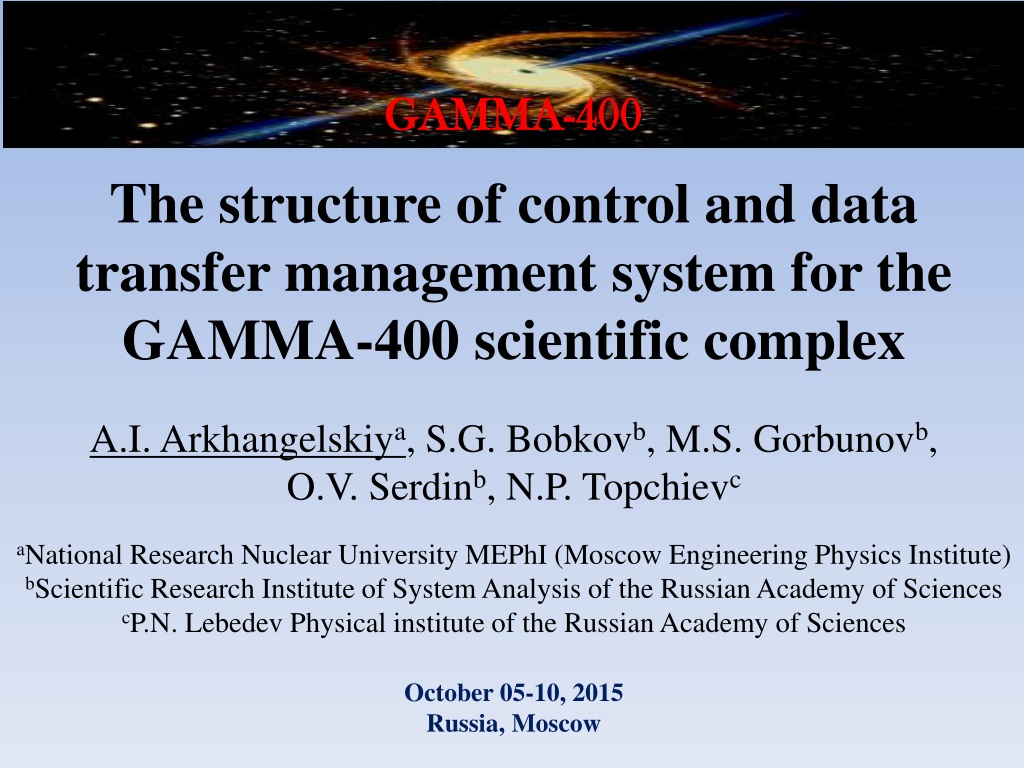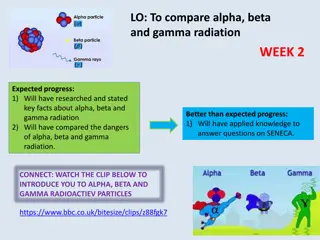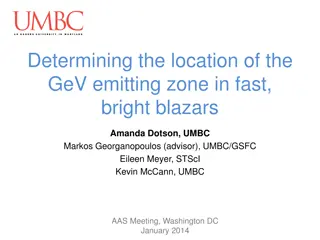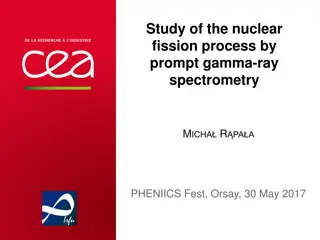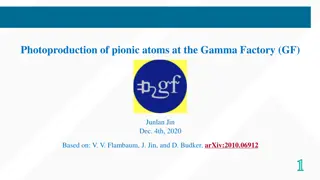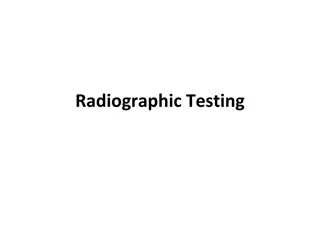Overview of GAMMA-400 Scientific Complex
The GAMMA-400 Scientific Complex, designed by experts from National Research Nuclear University MEPhI and other institutions, consists of a gamma-ray telescope, space observatory, and various detectors for studying cosmic gamma emission, electron/positron fluxes, and cosmic-ray nuclei fluxes. The complex will be launched on the NAVIGATOR service module into high apogee orbit, enabling detailed measurements and observations with high energy and angular resolutions. Key subsystems include a gamma-ray burst monitor, star sensors, magnetometers, and more, providing valuable insights into space phenomena.
Download Presentation

Please find below an Image/Link to download the presentation.
The content on the website is provided AS IS for your information and personal use only. It may not be sold, licensed, or shared on other websites without obtaining consent from the author. Download presentation by click this link. If you encounter any issues during the download, it is possible that the publisher has removed the file from their server.
E N D
Presentation Transcript
GAMMA GAMMA- -400 400 The structure of control and data transfer management system for the GAMMA-400 scientific complex A.I. Arkhangelskiya, S.G. Bobkovb, M.S. Gorbunovb, O.V. Serdinb, N.P. Topchievc aNational Research Nuclear University MEPhI (Moscow Engineering Physics Institute) bScientific Research Institute of System Analysis of the Russian Academy of Sciences cP.N. Lebedev Physical institute of the RussianAcademy of Sciences October 05-10, 2015 Russia, Moscow
Space project GAMMA-400 is intended for measurements of characteristics of cosmic gamma-emission in the energy band from ~20 MeV up to several TeV, electron/positron fluxes from ~1 GeV up to ~10 TeV and cosmic-ray nuclei fluxes with energies up to ~1015eV by means of GAMMA-400 gamma- telescope represents the core of the scientific complex. The investigation of gamma ray bursts over virtually the entire celestial sphere in the energy band of 10 keV 15 MeV are possible too by means of KONUS-FG GRB monitor in simultaneous operation with the GAMMA-400 gamma- telescope. For -rays in the energy region from 10 to 100 GeV expected energy resolution is from ~3% to ~1% and angular resolution from ~0.1% to ~ 0.01% respectively, /protons rejection factor is ~5 105.
The GAMMA-400 space observatory will be launched on the NAVIGATOR service module Association on the high apogee orbit with following initial parameters: apogee altitude ~300000 km; perigee altitude ~500 km; rotation period ~7 days; inclination to the equator plane 51.4 . After approximately half a year the orbit will evolve into an almost circular orbit with radius of ~150000 km, i.e. the observatory will fully leave the Earth s radiation belts. The expected lifetime will be more then 7 years. The planned scientific complex main technical parameters are: total weight ~4100 kg, power consumption ~2000 W, information quote 100 GByte/day. designed by Lavochkin
GAMMA-400 gamma-ray telescope Star sensors (2) Magnetometers (2) Thermal regulation system Gamma-ray burst monitor KONUS-FG 4 direction detectors 2 spectrometric detectors NAVIGATOR service module (LavochkinAssociation) GAMMA-400 scientific complex on the NAVIGATOR service module
The core of scientific complex gamma-telescope GAMMA- 400 includes following subsystems and detectors: anticoincidence system (AC: ACtop top detector and AClat four lateral detectors AClat1 AClat4; lateral calorimeter detectors (LD four detectors LD1 LD4); time-of-flight system (TOF two detectors S1, S2); scintillation detectors of calorimeter (SDC two detectors S3, S4); converter-tracker (C four towers C1 C4); position-sensitive calorimeter (position-sensitive converter- calorimeter CC1, total-absorption calorimeter CC2); neutron detector (ND); system of triggers and counting signals formation (ST).
GAMMA-400 apparatus can be subdivided into two main parts: GAMMA-400 scientific complex and NAVIGATOR service platform systems directly providing the operation of scientific complex. GAMMA-400 scientific complex consists of the following systems: gamma-telescope GAMMA-400; gamma-ray burst monitor KONUS-FG (four directional detectors and two spectrometric detectors); two magnetometers (M1, M2); two star sensors (SS1, SS2) for determining the GAMMA- 400 axes with accuracy of approximately 5 ; Scientific Complex Telemetry System (SCTS); Scientific DataAcquisition System (SDAS); Pulse Commands and Power Supply System (PCPSS).
In GAMMA-400 equipment next systems are used: Onboard Complex of Control including command and scientific radio lines, satellite control devices, satellite onboard control system, onboard time and frequency standard; Onboard Telemetry System (OTS) control of digital parameters, analogous parameters and thermo sensors. Scientific DataAcquisition System (SDAS); Pulse Commands and Power Supply System (PCPSS). For the control of all scientific equipment, one can use: up to 100 commands in the form of either voltage pulse with duration ~0,1 0,3 sec with amplitude equal to satellite power or dry contacts pulse on/off or switch on/switch off; up to 65535 programming commands (16-bits control words). project for controlling the scientific
The SDAS is the information kernel of scientific complex. SDAS is a distributed system for acquisition, pre-processing and registration data from scientific measuring systems (SMS). Data encryption is used to reduce the quantity of transmission failures. In order to increase the reliability, SDAS is made using a scheme with two hot- and cold-reserve subsystems. All SC-SDAS data exchange signals are double redundant; each redundant line is assigned with its own allocated data transceiver. Additional reliability level of SDAS is achieved by minimization of high integrity chips amount. Precise timing of scientific data is maintained in SDAS by using signals from onboard time and frequency standard system (OTFS), forming a 32-bit serial onboard time code (OTC) transmitted to each SMS via GPIO/LVDS interface of central processing unit (CPU) of SDAS along with high-stable reference signals (SYNC).
The SDAS carries out the following main functions: the data acquisition from measuring systems of scientific complex (up to 100 GByte per day); preliminary data processing of scientific information and storage it in nonvolatile mass memory (1 TByte total); scientific information transfer into high-speed (320 Mbit/sec) scientific radio line (SRL) for its transmission to data- acquisition ground stations; control information reception from spacecraft onboard control system (OCS), its decoding and transfer into SMS; receiving signals from OTFS/OCS and generating OTC and SYNC signals for SMS. Functional diagram of GAMMA-400 scientific complex including interconnection channels within complex and across it and NAVIGATOR service platform systems is shown on the next slide
Estimated dataflow (unpacked) from various scientific complex systems in the main registration mode Scientific complex subsystem Event regime (Byte/events) Patrol regime (Byte/day) Continuous measurements (Byte/day) - C1-C4 4 x 50 k = 200 k - AC, S1, S2, LD, ST CC1, CC2, S3, S4, ND SCTS, M1, M2, SS1, SS2 KONUS-FG 2 k 120 M - 123 k 680 M - - - 70 M - - 20 M TOTAL 325 k 800 M 90 M
SUMMARY The structure of the onboard control complex and of the data transmission system from scientific instruments for the GAMMA-400 apparatus satisfies all scientific complex requirements. The use of a distributed system involving the scientific complex and service systems of the NAVIGATOR service module provided possibility operational management of the parameters from various instruments, as well as acquisition and transmission to ground of complete streams of data about all types of sensors and data about study and operational integrity of the scientific complex subsystems. for adaptive and
